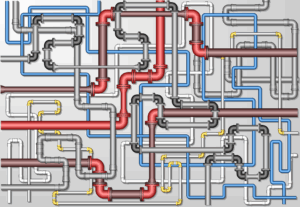The Future Is Here?
Technology seems to be a common thread that connects several disruptive innovations. Perhaps it’s no surprise that at least some of these have been touted before and remain top of mind as they still hold much potential and promise of a better and improved future—a connected and smarter future where home, work and play are blended like never before. Oh, did we mention artificial intelligence (AI)? Certainly, these are technologies that can induce change, where industries can be improved upon, developed and transformed through innovation, from manufacturing and healthcare to finance and commerce and more.
In broad strokes, while perhaps not groundbreaking, several lists we researched on this topic referenced 5G, AI, Blockchain, Internet-of-Things (IoT), and Metaverse as disruptive technologies which will continue to transform the way we live and work as well as shape the future. These are disruptive innovations that will quite possibly change our lives and transform the experience—of consumers and of entire industries—and which will continue to bring about change, both large and small, to society.
“By understanding and harnessing the power of these disruptive technologies, leaders can stay ahead of the curve and drive innovation and growth in their organizations,” says JD Meier, in his blog, “The Top 5 Disruptive Technologies Shaping the Future in 2023.”
Diving deeper into each core category, of course, one might glean ever more specific trends in these disruptive technologies—from quantum computing and AI to the latest in biotechnology. Just what is disruptive technology? Much like disruptive innovation, “Disruptive technology is an innovation that causes major change in the way consumers, businesses and industries operate. A disruptive technology has the potential to replace the existing systems or habits through its attributes that are measurable and superior,” writes Simplilearn in its blog, “Top Disruptive Technologies to Watch Out for in 2023.” Simplilearn’s list of top tech disruptors drills a little deeper and includes:
- 3D Printing
- 5G and Improved Connectivity
- Artificial Intelligence and Machine Learning
- Automation and Robotics
- Cyber Security Advances
- Edge Computing
- Virtual and Augmented Reality
- Headless Tech
- The Rise of “As-a-Service” Computing
- The Work-From-Home Revolution
- Voice-Activated Searches
Pardon the Disruption: Understanding Disruptive Innovation
In “Defining Disruptive Innovation,” All Things Innovation examined the topic in more detail. Disruptive innovation is often a phrase used to make a splash in the business world. Some may debate that the label has been applied carelessly at times to anyone shaking up the market. Yet, just what makes an innovation disruptive? It depends on your point of view. But some make the case that it still remains a gradual process of change, as a smaller competitor gains a foothold in a low-end or new market, and moves its product upmarket to challenge the incumbents. Disruptive innovation encompasses a transformation at the core of the business and the marketplace.
Speaking of technology, at FEI, All Things Innovation conducted a special roundtable, bringing cross industry, cross disciplinarians together to talk about transformation and how to make it a reality. In “Achieving Transformational Innovation,” these leaders discuss transformational innovation, digital transformation, and the decision making around it, which often can lead to disruptive forces, both technological and otherwise.
2024 Disruptive Innovation Trends
Along with constantly evolving top tech innovations in 2023, why not look ahead to 2024 and beyond? While there are some redundancies to these lists, LinkedIn’s blog, “Disruptive Innovations Coming in 2024: Transforming Industries with Cutting-Edge Technologies,” takes a shot at predicting what might come next. These innovations, of course, will likely drive further innovations in the future.
- 5G Technology: 5G technology is set to transform the way we connect and communicate. It will also enable widespread adoption of artificial intelligence (AI) and automation.
- Unsupervised Machine Learning: Unsupervised machine learning (UML) is poised to disrupt the field of data analytics, LinkedIn notes. Unlike traditional machine learning approaches, UML can recognize and flag unknown patterns without the need for data training or labeling, which will unlock new insights and improve predictions.
- Robotic Accuracy and Automation: Advancements in robotics and automation will bring more human-like intelligence to machines.
- Intelligent Tech Revolutionizing Security: Artificial intelligence and machine learning are poised to revolutionize the way organizations approach cybersecurity.
- Connected Telehealth Solutions: In 2024, telehealth applications, when integrated with electronic health records and other platforms, will reshape healthcare delivery.
- Augmented and Virtual Reality: Augmented reality (AR) and virtual reality (VR) technologies are becoming more capable and cost-effective.
- Hyperautomation: Hyperautomation combines artificial intelligence and machine learning to automate complex business processes.
- Edge Computing: Moving processing closer to the user with edge computing will unlock the full potential of AI and machine learning.
- Spatial Computing: Spatial computing offers new ways to interact with digital content using gestures, voice commands, and eye tracking.
- Software-Driven Innovation: Digital innovation will become a key driver of revenue for enterprises in 2024.
Video courtesy of Bernard Marr
Contributor
-

Matthew Kramer is the Digital Editor for All Things Insights & All Things Innovation. He has over 20 years of experience working in publishing and media companies, on a variety of business-to-business publications, websites and trade shows.
View all posts

























































































































































































